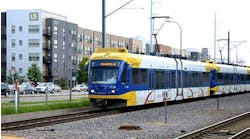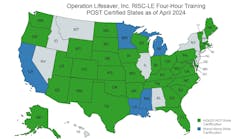The Metropolitan Transportation Authority launched wireless voice and data communication capability in six subway stations, allowing New York City subway riders to make and receive cell phone calls, send tweets and receive e-mail underground. MTA officials were joined by executives from Transit Wireless, AT&T and T-Mobile to demonstrate the new capability at the 14th Street-8th Avenue station a full 10 months ahead of schedule.
Transit Wireless expects to provide service to the remaining 271 underground stations within four years and has already begun design work on the next 30 stations on the west side of Manhattan, including Times Square, Herald Square and Columbus Circle. Those 30 stations are expected online in the next 12 months.
As part of the service, E911 also provides added security underground with uninterrupted access to 911 and the ability for 911 dispatchers to know when a call is being placed at street level or underground in the subway. Under agreements with the MTA and Transit Wireless, AT&T and T-Mobile customers can now use their cell phones and also send and receive wireless data messages at the following six stations:
- A, C, E station at Eighth Avenue and West 14th Street;
- L station at Eighth Avenue and West 14th Street;
- C, E station at Eighth Avenue and West 23rd Street;
- 1, 2, 3 station at Seventh Avenue and West 14th Street;
- F, M station at Sixth Avenue and West 14th Street;
- L station at Sixth Avenue and West 14th Street.
"Bringing wireless service into our subway system is the latest milestone in the MTA's effort to use technology to improve the service we provide for our customers," said MTA chairman and CEO Jay H. Walder. "Whether you're checking your email, calling your kids or looking for emergency assistance, wireless service will bring the conveniences we're used to throughout our lives into the subway system."
"Working with the Metropolitan Transportation Authority, AT&T and T-Mobile, Transit Wireless has created a win-win-win scenario in the New York City subway system," said Transit Wireless CEO William A. Bayne Jr. "Commuters have improved access to communication; the MTA realizes additional revenue and the wireless carriers can provide added value to their customers."
"Whether above or below ground, New Yorkers want and need access to their wireless phones and other devices, and AT&T is excited to begin providing subway riders with this service in several of the city's subway stations," said Mike Maus, assistant vice president Network Engineering, AT&T. "AT&T is committed to providing customers with the best mobile broadband and Wi-Fi experience, whether they're at work, at home, on the street, in a subway station or in the parks."
"T-Mobile is excited to work with Transit Wireless and the MTA to offer wireless service to the thousands of T-Mobile customers that use these subway platforms daily," said Terry Hayes, vice president general manager, New York City, T-Mobile USA. "This effort is another great example of T-Mobile's continued investment in New York City to expand our 4G network, providing more value and connectivity to our customers."
Transit Wireless and the carriers are paying 100 percent of the cost of the project, estimated at up to $200 million, including the cost of NYC Transit forces that provide flagging, protection and other support services. The MTA and Transit Wireless would also evenly split revenues from occupancy fees paid by the wireless carriers and other sub-licensees of the network. Transit Wireless will pay the MTA a minimum annual compensation of $3.3 million once the full build out of the network is complete.
As a neutral host, Transit Wireless welcomes all wireless carriers to sign on. AT&T and T-Mobile have agreements covering the six stations which went live today, with the option to expand as additional subway stations come on line. Negotiations with other carriers are ongoing. Transit Wireless also expects to establish sublicense arrangements with Wi-Fi providers to give customers additional data and internet access in the near future.
Underground Subway Wireless Service – How it works
Wireless carriers who have contracted with Transit Wireless to provide voice and data service to their customers in underground New York City subway stations co-locate their Base Stations with Transit Wireless' Optical distribution equipment at a Transit Wireless Base Station Hotel, which is a resilient, fault-tolerant commercial facility with redundant air-conditioning and power.
Base Stations are provided by wireless carriers for each band and technology; 700-LTE, 850-Cellular, 1900-PCS, 2100-AWS and other. These Base Stations connect to Transit Wireless' Radio Interface and Optical Distribution System in the Base Station Hotel. Radio signals are combined, converted to optical signals and distributed on Transit Wireless' fiber optic cable through ducts under city streets to subway stations where the optical cables connect to multi-band Remote Fiber Nodes.
Remote Fiber Nodes are located on every platform, mezzanine and at various points within public access passageways. Coaxial cable is connected to each Remote Fiber Node and extends signals to strategically located antennas throughout each subway station. Utilizing this approach, low-level radio signals are evenly distributed providing seamless coverage from above ground to underground stations.
A Network Management System monitors the service; detects problems and provides alerts so technicians can be dispatched if needed.


